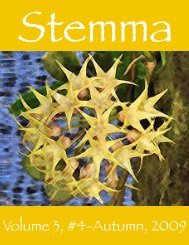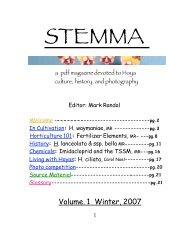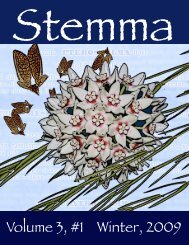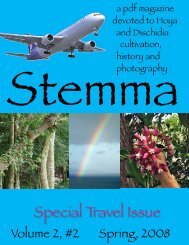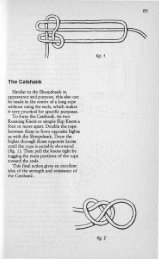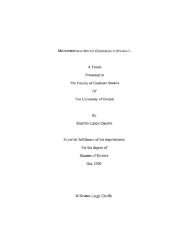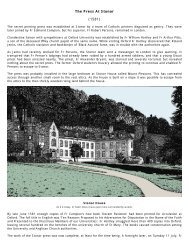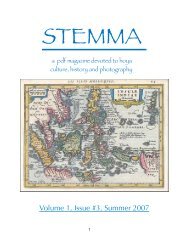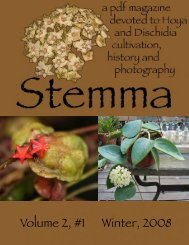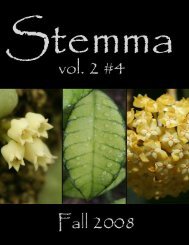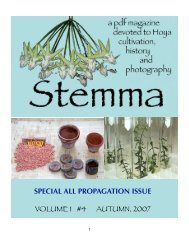Volume 3, Issue #2 - Cubits
Volume 3, Issue #2 - Cubits
Volume 3, Issue #2 - Cubits
Create successful ePaper yourself
Turn your PDF publications into a flip-book with our unique Google optimized e-Paper software.
26: genus Eriostemma (Schltr.) D. Kloppenburg & Gilding<br />
Etymology: “Erio” = “wooly”, Gr. + “stemma” = “crown”, Gr.<br />
Type species: Eriostemma coronaria (Blume) D. Kloppenburg & Gilding.<br />
Overall form: these species are rampant, twining lianas which have a terrestrial, rarely or never epiphytic,<br />
habit. Leaves are medium-sized, ovate-acute, pinnately veined, with no silver splotching. Except<br />
for the interior of the corollas and the upper coronas of these species, mostly all parts of the foliage and<br />
flowers are covered with dense to scattered hair. Flowers are large to giant-sized, thick, mostly rotate but<br />
occasionally reflexed (E. ciliata) or shallowly cup-shaped (E. lauterbachii), usually not strongly fragrant,<br />
ranging in color from white and pale green through pink and orange to dark brownish-red.<br />
Distribution: tropical Australia, New Guinea, Indonesia, Malaysia, Thailand, the Philippines.<br />
Publication: (as a section) Schlechter, 1914. “Die Asclepiadaceen von Deutsch-Neu-Guinea”.<br />
Botanische Jahrbücher für Systematik, Pflanzengeschichte und Pflanzengeographie 50 (sup.): 81--164;<br />
(as a genus) D. Kloppenburg & Gilding. Fraterna 14(2). 2001.<br />
Original description: (translated from German by Dieter Paul & Dale Kloppenburg) “...the stems and<br />
leaves with all surfaces (parts) covered with short soft hairs; in other respects its blooms possess marked,<br />
sharp characteristics..... The gynostegium stands upon a column which goes down into the crown of the<br />
collar of the corolla which is covered with shaggy cottony hairs. The corona scales are comparatively<br />
short. The blooms are large or very large with a well developed, thickly hirsute calyx. Type species of<br />
the section is H. coronaria Blume.”<br />
Also, from the same publication: “I thought it best to present here this distinctive section Eriostemma.<br />
This section is so well and sharply different, that one could consider whether or not to regard it as a<br />
separate sub-genus. I have so far presented above briefly the main points, but now I wish to present<br />
them once again in more detail. In habit there is a strong similarity that can be found with EU-Hoya, but<br />
the branches are softer and more fleshy and consistently with more or less soft hairs. The peduncles are<br />
extraordinarily thick and soft textured, the calyx as with Pterostelma more strongly structured, and the<br />
large hairy blooms are likewise fleshy. The gynostegium with the corona scales stand upon a woolly matted<br />
column that is the outgrowth formed of the filaments, which are united with the corona tube. The<br />
pollinia are distinguished (marked) as opposed to the other Hoya species by means of the fact that the<br />
translators have undergone a strong development and exhibit a twist; also the retinaculum is rather large.<br />
The pollinia are more club shaped and moreover do not have the keel on the outer edge, characteristic<br />
of other Hoya sections.”<br />
22



